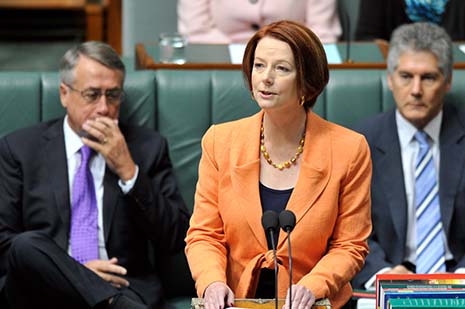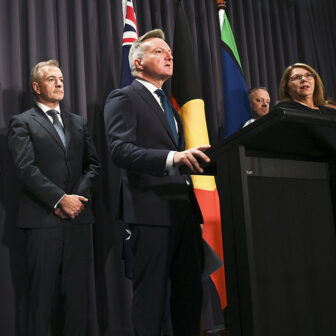EACH February since 2008 the federal government has highlighted its commitment to “closing the gap” in Indigenous disadvantage by reporting the progress made in tackling this critical issue. There can be no doubting the sincerity of the commitment, backed by funding support amounting to $9 billion through the National Partnership Agreements created by the Council of Australian Governments, or COAG. But the fact remains that progress can only be measured so far in two of the six target areas and this progress is miniscule compared to the size of the gap.
The prime minister’s latest Closing the Gap report is 121 pages long – twice the size of last year’s report, with over one hundred photos but just five figures and charts. Only the first twenty-four pages relate to the stated targets for the overall program, although it is true that these will only be met if and when the issues addressed elsewhere in the report – housing, economic participation, safe communities, land rights and social justice – are also tackled.
In my analysis of last year’s report I was critical of the paucity of quality data and the difficulty in measuring outcomes. This year’s report is just as short of information. The COAG Reform Council’s National Indigenous Reform Agreement Performance Report for 2009–10, released in April last year, gives reason to hope that a framework for monitoring and accountability is now in place. But we must await next year’s prime minister’s report, which should include relevant statistics from the 2011 census, before we know if this hope is justified.
What do these two reports say about progress to date?
Target: Close the life expectancy gap within a generation (by 2031)
With no new data available on life expectancy at birth until 2013–14, the push has been to use a proxy measure – all-causes mortality rates – to measure progress against this target. But the very best interpretation that can be put on this measure is that progress in tackling all-cause mortality has slowed in recent years.
Recent data from Australian Indigenous HealthInfoNet show that, for those jurisdictions with reasonable information about Indigenous deaths, the median age at death in 2010 for males ranged from 50.8 years in the Northern Territory to 58.3 years in New South Wales. The median age at death for Indigenous females in 2010 ranged from 55.4 years for those living in the Northern Territory to 67.1 years for those in New South Wales. For both males and females, the gap between these rates and those for non-Indigenous Australians was about twenty years. The fact that age-specific death rates are highest in the young and middle adult years doesn’t augur well for increases in life expectancy.
Most of this gap is due to accidents, suicide and chronic disease – all of which are preventable. Tackling risk factors such as smoking, alcohol abuse and obesity, and better managing diabetes, cardiovascular disease and respiratory disease, could make inroads into the dramatically higher mortality rates for these conditions in the Indigenous population.
While Indigenous people are receiving more healthcare services, it’s not clear how effective they are and whether the increase is in primary or acute care services. The government cites the Indigenous Chronic Disease Package here, but the number of health assessments conducted (49,000 in 2010–11) and the number of patients registered for chronic disease care (32,000) need to be boosted dramatically for this program to deliver results.
According to the trajectory, to close the life expectancy gap of 11.5 years for males and 9.7 years for females, Indigenous life expectancy will need to increase by an estimated twenty-one years for males and sixteen years for females over the next two decades. From the current perspective, this seems a monumental task.
Target: Halve the gap in mortality rates for Indigenous children under five by 2018
If the current trend continues, according to the prime minister’s report, this target will be met by 2018. This is possible, but it’s of concern that the data for 2008, 2009 and 2010 have been reported differently in different years of the reports (presumably owing to ABS revisions) and are also reported differently in the COAG report. COAG also cautions that under-identification of Indigenous status means that the recorded number of Indigenous child and infant deaths is likely to understate of the actual number of deaths. Still, some strength is given to the report’s position by improvements in infant mortality rates, which consistently declined in 2007, 2008 and 2009.
A number of indicators (low birth weight; tobacco smoking during pregnancy; hospitalisation rates; antenatal care) will be used by COAG to measure progress towards this target, but no data after 2008 have been provided in support of these indicators.
Target: Ensure access to early childhood education for all Indigenous four-year-olds in remote communities by 2018
The COAG and prime minister’s reports state that there are no current data to gauge progress against this target. That’s a little surprising given that there is information from the annual National Preschool Census, which shows that in 2010, 90 per cent of children in remote and very remote areas were enrolled in preschool in the year before school. This is considerably better than enrolments for Indigenous preschoolers in major cities (53 per cent) and regional areas (65 per cent).
Target: Halve the gap in reading, writing and numeracy achievements for Indigenous children by 2018
Both reports indicate that Indigenous children are doing better at school with improvements in results from NAPLAN (the National Assessment Program – Literacy and Numeracy). In seven of the eight areas in which progress can be assessed at the national level, the gap with non-Indigenous students narrowed between 2008 and 2011.
Unfortunately the prime minister’s report presents comparative data for Indigenous and non-Indigenous students only for 2011. Given that these assessments are done annually, there seems to be no reason why comparative figures aren’t provided. Even then, progress could prove elusive. The NAPLAN numeracy results, for example, show that scores for Indigenous students in all grades were higher in 2008 than they were in 2011. The reverse is true for reading scores. Simply measuring the gap will not guarantee that improvements are achieved and sustained.
National scores also hide the educational problems that exist in more remote schools. For example, in 2011 only 26.4 per cent of Indigenous Year 5 students in very remote areas achieved at or above the National Minimum Standard in reading compared to 76.7 per cent in metropolitan areas. Non-Indigenous students in Year 5 scored at 86.6 per cent in very remote areas and at 93.4 per cent in metropolitan areas.
Target: Halve the gap for Indigenous students in Year 12 (or equivalent) attainment rates by 2020
No new figures will be available to measure progress against this target until the 2011 Census data are released in late 2012. The baseline retention rate is 47.4 per cent in 2006. In 2010, the ABS’s “apparent retention rate” for full-time Indigenous students to Year 12 was 47 per cent, although 96 per cent of Indigenous students stayed on to Year 10.
Attention also needs to be given to school attendance rates. It is unacceptable that almost a third of Indigenous fifteen-year-olds in remote areas of Australia and a quarter of Indigenous fifteen-year-olds in major cities are not at school. And there is reason to believe that school retention rates are getting worse, not improving. Figures released in the Productivity Commission's 2011 Report on Government Services show attendance rates for Year 10 students at public schools between 2007 and 2009 falling in every state and territory except Western Australia, where they were stable.
Target: Halve the gap in employment outcomes between Indigenous and other Australians by 2018
In 2008, 53.8 per cent of Indigenous people aged fifteen to sixty-four were in the workforce in Community Development Employment Projects or mainstream employment. No new data is available to indicate progress since then.
CDEP was reformed in July 2009 and capped at 15,000 participant places, of which 10,704 were filled at 30 June 2011. In 2010–11, 2057 participants moved from CDEP into jobs in the external labour market. In 2011, 95,874 Indigenous people were registered with Job Services Australia, 46,486 job placements were made and there were 21,807 education and employment outcomes. The proportion of job seekers in a job and/or education and training three months after they received assistance from Job Services was 44.7 per cent. As these figures indicate, getting Indigenous job seekers into placements that result in long-term employment is not easy.
CLOSING the gap is a long-term challenge. It will require a sustained effort over many decades by governments, business, communities and all Australians, Indigenous and non-Indigenous. As this year’s prime minister’s report and related documentation highlights, progress towards meeting the ambitious targets established in 2008 is hindered by decades of under-investment in services and infrastructure as well as difficulties in generating, collecting and using the data and information required to ensure that services are effectively targeted and achieve the required outcomes. In many cases even the baseline data are inadequate.
The funding provided to support these efforts through National Partnership Agreements is already running out. The agreements for health and the Northern Territory expire in June this year, as does funding for the Indigenous Tobacco Control Initiative. The sustainability of efforts in these areas is stymied when there is no certainty that new funds will be provided in the 2012–13 federal budget.
Ultimately, though, closing the gap is not about funding or empirical measures. It is, as the prime minister has stated, “a project that should move us deeply” and “which will make such a difference in so many individual lives.” •




